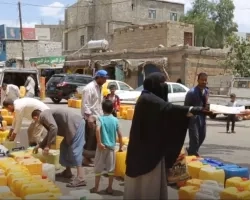In commemoration of the United Nations' designation of February 11, 2021 as an International Day of Women and Girls in Science the Applied Sciences Program is highlighting some of the recent work by members of the team.
Identifying Opportunities with Helena Chapman - Helena Chapman is an associate program manager for the Earth Applied Sciences' Health and Air Quality program. She is both a physician and has a Ph.D. in public health with a concentration in “One Health,” a concept recognizing the interconnectedness between human, animal and environmental health. Chapman uses her expertise to identify research and programmatic gaps in the field and find innovative solutions and also supports the Group on Earth Observations (GEO) Health Community of Practice, a global network of governments, organizations and observers which promotes the use of Earth observation data in health decision-making at local, national and international levels.
Geospatial Accolades for Award Winning Africa Flores - Africa Flores of SERVIR Amazonia received the “Geospatial Woman Champion of the Year” award in 2020 for her work to increase the use of Earth observations across environmental programs and inspire women around the world. Selected for being the undisputed leader of the year in her field, Flores’s award recognizes her for developing Earth observations capacities with enthusiasm and innovative thinking, especially in support of resource conservation in her home country of Guatemala and Latin America
Maggi Glasscoe and Dalia Kirschbaum: Collaborating to Improve Flood and Landslide Monitoring - Glasscoe and Kirschbaum worked together to improve landslide and flood alerting by the DisasterAWARE platform, a product of the Pacific Disaster Center (PDC). Margaret “Maggi” Glasscoe is a geophysicist at NASA’s Jet Propulsion Laboratory (JPL) and is principal investigator for a project that assesses floods on a global scale and creates risk alerts as part of the NASA Earth Applied Science Disasters program area. Dalia Kirschbaum is the chief of the Hydrological Sciences Laboratory at NASA’s Goddard Space Flight Center and a research scientist, where she focuses on regional and global landslide hazard modeling. She is the principal investigator for a Disasters program area that uses satellite data to study where and when landslides may be happening around the world. More about their collaboration in the article titled, Early Access to Global Flood Tracking.
Powered by Plants: How Emily Kennebeck broadens NASA Earth observation uses for United Nations Sustainable Development Goals (SDGs) - As a NASA intern, Purdue University student Kennebeck worked with the Program's Argyro Kavvada, SDG program manager on projects that support the use and integration of Earth observations or models in countries’ activities to meet SDGs in the context of climate variability and change. These Global Goals were developed to promote a more sustainable environment in which all species can live, and in which all humans can live with equal footing across gender, class, race, faith and other important factors. The UN member states have agreed to strive to meet these goals by 2030.
Managing the Navajo Nation's Water Resources with NASA Data - Nikki Tulley is a member of the Navajo Nation and as a summer intern with NASA's Western Water Applications Office, helped the Navajo Nation Drought Project built a cloud-based web application called the Drought Severity Evaluation Tool (DSET). It improves drought reporting and management in the Navajo Nation and combines satellite data, modeled inputs, and in-situ data from the Navajo in a web-based platform.
Creating a Global Community - Betzy Hernández is an associate program manager for the NASA Earth Capacity Building program area, a Capacity Building lead within the SERVIR Science Coordination Office (SCO) and a research associate at the University of Alabama in Huntsville, Hernández is skilled at creating worldwide connections. She helps countries strengthen their understanding of Earth observations so they can use these data to find solutions to local challenges.
Shayna Skolnik: Visualizing Disasters Impacts with Virtual Reality - Shayna Skolnik is the founder and CEO of Navteca, a woman and minority-owned technology company that focuses on emerging technologies and IT innovations through artificial intelligence, cloud solutions and advanced data visualization. Through Navteca, Shayna collaborates with NASA to demonstrate and investigate the potential of virtual reality (VR) and augmented reality (AR) to improve data accessibility and visualization for Earth science research and disaster response efforts.
Nancy Searby Receives GEO Excellence Award - Nancy Searby, program manager for NASA’s Earth Science Applied Sciences Capacity Building program area, received a 2020 Individual Excellence Award from the Group on Earth Observations (GEO). GEO recognized Searby for demonstrating exceptional personal commitment to the GEO mission.










